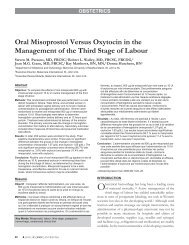Kirsten Grabowska - UBC Department of Obstetrics & Gynaecology
Kirsten Grabowska - UBC Department of Obstetrics & Gynaecology
Kirsten Grabowska - UBC Department of Obstetrics & Gynaecology
Create successful ePaper yourself
Turn your PDF publications into a flip-book with our unique Google optimized e-Paper software.
Jacobson et al 119Conclusion: In a large managed care organization, glyburide was at least as effective as insulin inachieving glycemic control and similar birth weights in women with GDM who failed diettherapy. The increased risk <strong>of</strong> preeclampsia and phototherapy in the glyburide group warrantfurther study.Ó 2005 Mosby, Inc. All rights reserved.Gestational diabetes mellitus (GDM) complicates 2%to 5% <strong>of</strong> pregnancies and is associated with significantmaternal and neonatal morbidity and mortality. 1 In theUnited States, traditional therapy for women withGDM who fail diet therapy has been insulin. In awell-controlled randomized trial, Langer et al 2 demonstratedthat glyburide was a clinically effective alternativeto insulin in women with GDM. Despite limitedclinical studies, recent expert opinion has suggestedglyburide as an alternative first choice for GDM, anda survey in 2003 found that 13% <strong>of</strong> obstetriciangynecologistsbegin with glyburide for patients requiringtherapy beyond diet. 3,4 The aim <strong>of</strong> this study is to reportour experience after the introduction <strong>of</strong> a protocol forglyburide treatment <strong>of</strong> GDM in a large managed careorganization.Material and methodsWe performed a retrospective study in women diagnosedwith GDM requiring medication in the 2-yearperiod before the introduction <strong>of</strong> glyburide to womenwho received a diagnosis <strong>of</strong> GDM in the 2 years after itsintroduction at a large managed care organization. Thesetting for this study was the Kaiser Permanente NorthernCalifornia Medical Care Program (KPNC). KPNCis a prepaid group-model managed care organizationthat provides comprehensive medical services to morethan 3 million members in a 14-county region, servingapproximately 30% <strong>of</strong> the population in the area. TheKPNC membership approximates the sociodemographics<strong>of</strong> the general population in the region, exceptfor the extreme tails <strong>of</strong> the socioeconomic distribution.In February 2001, the KPNC Perinatology Groupintroduced guidelines for the use <strong>of</strong> glyburide for thetreatment <strong>of</strong> GDM.Eligibility for the study was limited to women withsingleton pregnancies who had GDM diagnosed between12 and 34 weeks between January 1999 andDecember 2002. Additional inclusion criteria includedan abnormal 50 g glucose load test (GLT) <strong>of</strong> 140 mg/dLor greater and a diagnostic 3-hour glucose tolerance test(GTT), using National Diabetes Data Group (NDDG)criteria (fasting R105, 1 hour R190, 2 hours R165, 3hours R145 mg/dL). 5 Patients were excluded if they hada fasting plasma glucose greater than 140 mg/dL onGTT. Patients delivered at 9 hospitals: 5 with neonatalintensive care units (NICUs) and 3 with level II nurseries.First- and/or second-trimester ultrasounds arestandard practice in KPNC and were used for datingmost patients. Two primary groups were defined: theinsulin group with GDM diagnosed in 1999 through2000 and the glyburide group with GDM diagnosed in2001 through 2002. We also report on data collected onpatients with GDM diagnosed in 2001 through 2002who met study criteria but were treated with insulin notglyburide (ING group).General management <strong>of</strong> patients diagnosed withGDM included: nutritional counseling on a diabeticdiet for pregnancy with 3 meals and 3 snacks; andinstruction on self-monitoring capillary blood glucose(BS) with a glucometer. Patients were advised to monitorBS 4 times a day: fasting and either 1 or 2 hourspostprandials (per individual provider preference) forbreakfast, lunch, and dinner. Specific goals for plasmafasting, 1 hour, and 2 hours postprandials were 100, 155,and 130 mg/dL, respectively. Patients were required tohave capillary BS evaluation for a minimum <strong>of</strong> 3 dayson an appropriate diet before initiating glyburide. Glyburidewas begun with an initial daily dose <strong>of</strong> 2.5 mgwith the morning meal. If glycemic control goals werenot met, as defined by the individual provider, the dosewas increased by 2.5 mg initially and thereafter by 5 mgweekly. If the dose exceeded 10 mg daily, twice dailydosing was considered. If glycemic goals were not met,as defined by the individual provider, on a maximumdaily dose <strong>of</strong> 20 mg, patients were switched to insulin.Patients started on glyburide were referred to theRegional Perinatal Nursing Services (RPNS) for entryinto a database for outcome assessment. At the discretion<strong>of</strong> the referring provider, a patient could befollowed by the regional Diabetes Home ManagementProgram (DHMP) or by their local GDM program. TheDHMP involved regular telephone contact by nursesskilled in the management <strong>of</strong> GDM, as well as entry <strong>of</strong>home capillary BS values into the Perinatal ManagementSystem database (PERMS) for outcome assessment.Reviews <strong>of</strong> clinical information databases and chartswere performed to obtain demographic data. Body massindex (BMI) was calculated by using first documentedweight during pregnancy. Preterm delivery (PTD) wasdefined as delivery less than 37 weeks’ gestationalage. According to the gestational age-specific weight
















